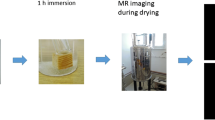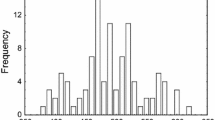Abstract
End-sealed 60×60×250 mm3 Pinus radiata pieces were dried at 65/37 °C (dry bulb/wet bulb temperature) and 4 ms-1 air speed to study various drying phenomena above fibre saturation point. While drying, an X-ray computed tomography (CT) scanner captured a cross-cut density image every ten minutes. The density data was used to determine moisture content, rate of moisture loss from the core, wetline (boundary line of the free water region) depth and cross-cut area of the wood pieces. Repeating patterns were observed, which indicated that the cavity-size distribution of the wood pieces dictated fluctuations in the rate of moisture loss from the core and cross-cut area shrinkage during drying in the free water phase.
It is hypothesised that, while drying an interconnected capillary network in the free water phase, the largest meniscus penetrates a wood piece through the largest cavities, thus also allowing air into the capillary network. The largest meniscus would always get smaller as it penetrates the wood piece until it is not the largest meniscus in the network anymore. Then the new largest meniscus would start penetrating the capillary network, etc. The largest meniscus would also determine the liquid tension in the capillary network. When the largest meniscus gets small enough, and the liquid tension strong enough, deformation and collapse of the remaining liquid-filled cavities can occur. A large liquid-filled interconnected capillary network would eventually fragment into a number of smaller liquid-filled interconnected networks, at which point a receding wetline could be observed.
Zusammenfassung
Zur Untersuchung verschiedener Phänomene bei der Trocknung oberhalb des Fasersättigungsbe- reichs wurden Pinus radiata Prüfkörper mit den Abmessungen 60×60×250 mm3, an den Hirnholzenden versiegelt, bei einer Trocken- bzw. Feuchttemperatur von 65 bzw. 37 °C und einer Luftgeschwindigkeit von 4 ms-1 getrocknet. Mittels Röntgencomputertomografie wurde im 10-Minuten-Takt die Rohdichteverteilung im Holzquerschnitt erfasst. Anhand dieser Daten wurden die Holzfeuchte, die Geschwindigkeit der Feuchteänderung im Kern, die Tiefe der Verdampfungsgrenze (Grenze des Bereichs mit freiem Wasser) sowie die Querschnittsfläche der Prüfkörper bestimmt. Dabei wurde ein sich wiederholendes Muster beobachtet, das darauf hinweist, dass die Größe der Hohlräume im Holz für die unterschiedliche Geschwindigkeit der Feuchteänderung im Kern und das Schwindmaß des Querschnitts während der Trocknung in der Freien-Wasser-Phase maßgebend ist.
Es wird angenommen, dass beim Trocknen eines Systems miteinander verbundener Kapillaren in der Freien-Wasser-Phase der größte Meniskus über den größten Hohlraum eindringt und dabei auch Luft in das Kapillarnetz gelangen kann. Der größte Meniskus wird beim Eindringen in das Holz immer kleiner, bis er nicht mehr der größte Meniskus im Netz ist. Daraufhin dringt der dann größte Meniskus in das Kapillarnetz ein, usw. Der größte Meniskus bestimmt auch die Flüssigkeitsspannung im Kapillarnetz. Wenn der größte Meniskus hinreichend klein und die Flüssigkeitsspannung hinreichend groß ist, kann es zu einer Verformung und zu einem Kollaps der restlichen, mit Flüssigkeit gefüllten Hohlräume kommen. Ein großes, mit Flüssigkeit gefülltes Kapillarnetz zerfällt letztendlich in etliche kleinere, mit Flüssigkeit gefüllte Netze, dabei ist ein Zurückweichen der Verdampfungsgrenze zu beobachten.
Similar content being viewed by others
References
Hawley LF (1931) Wood-liquid relations. USDA Tech Bull 248:1–34
Kreber B, Haslett AN, McDonald AG (1999) Kiln brown stain in radiata pine: a short review on cause and methods for prevention. For Prod J 49(4):66–70
Prat M (2002) Recent advances in pore-scale models for drying of porous media. Chem Eng J 86:153–164
Salin JG (2003) External heat and mass transfer – some remarks. In: Proc. 8th Int. IUFRO Wood Drying Conf., Brasov, Romania, pp 343–348
Salin JG (2006) Modelling of the behaviour of free water in sapwood during drying, Part I. A new percolation approach. Wood Mater Sci Eng 1:4–11
Scheepers GC, Danvind J, Morén T, Rypstra T (2005) An investigation of liquid water movement in Birch during drying through variation of wood sap surface tension and initial average moisture content. In: Proc. 9th Int. IUFRO Wood Drying Conf., Nanjing, China, pp 57–62
Stamm AJ (1967) Movement of fluids in wood – Part I: Flow of fluids in wood. Wood Sci Technol 1(2):122–141
Siau JF (1984) Transport Processes in Wood. Springer, New York
Spolek GA, Plumb OA (1981) Capillary pressure in softwood. Wood Sci Technol 15:189–199
Terziev N, Boutelje JB, Söderström O (1993) The influence of drying schedules on the redistribution of low-molecular weight sugars in Pinus sylvestris L. Holzforschung 47:3–8
Wiberg P, Morén TJ (1999) Moisture flux determination in wood during drying above fibre saturation point using CT-scanning and digital image processing. Holz Roh- Werkst 57:137–144
Author information
Authors and Affiliations
Corresponding author
Rights and permissions
About this article
Cite this article
Scheepers, G., Morén, T. & Rypstra, T. Liquid water flow in Pinus radiata during drying . Holz Roh Werkst 65, 275–283 (2007). https://doi.org/10.1007/s00107-007-0171-y
Published:
Issue Date:
DOI: https://doi.org/10.1007/s00107-007-0171-y




